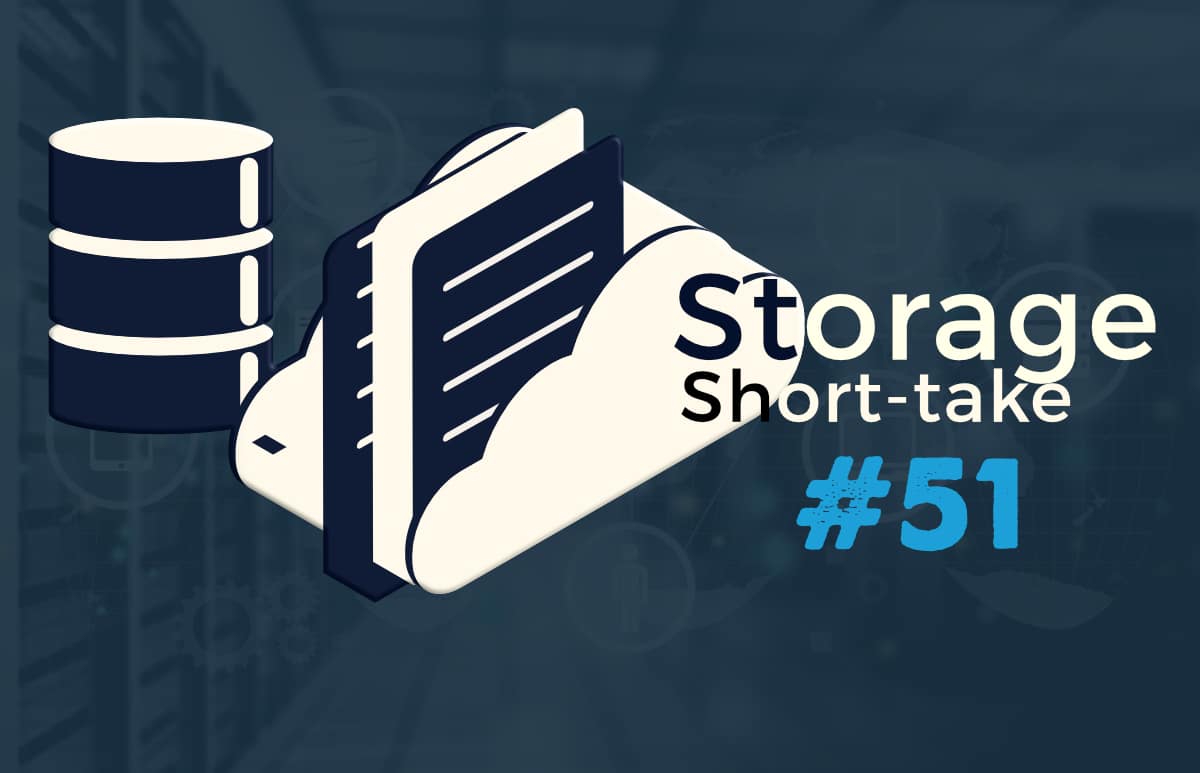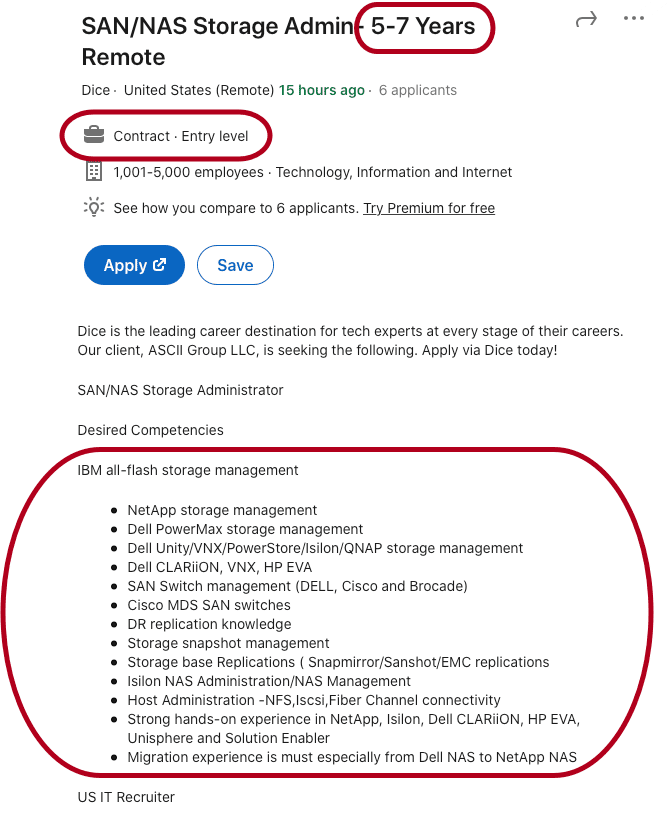
Since the last Short Take we've had the SNIA Storage Developer Conference (you can register on-demand for $95, btw, and it's a steal at the quality of content).
I'm not going to lie - I had an incredible amount of anxiety about going to the conference. Not because of the conference itself, mind you, but because of going to the conference. It was the first time that I'd been on a plane in 2.5 years, and I didn't know what to expect from people around me.
Worse, it's in California. I used to live there and have since moved out to a much less solipsistic part of the country. There are true moments of insanity there that go beyond just shaking your head.
Where I live, things are pretty much normalized from the way they have been in the past two years. At the conference, there was probably about 20-25% people masked up, but to say this was 'consistent' was a major overstatement. Sure enough, one guy cut out a hole in his paper mask for his mouth and nose so that he could breathe, but kept the tattered mask on his face.
I did finally come to understand why people with kids are very concerned about masks in schools from a psychological perspective. It was very difficult to hear people try to talk (especially at a conference, with many people talking at once), and very difficult to read facial expressions to get context and meaning.
I don't begrudge anyone their comfort - physical or emotional. Ultimately what they did had no effect on me (literally - many people who wore masks and even those with six boosters came away with Covid after the event; I did not). It's pretty clear, though, that while there were definitely some people who were trying their best to take precautions for health reasons, many more were doing it for theatrical purposes and virtue signaling.
Fortunately the content of the conference and the ability to chat with people face-to-face made it all worth it. I was able to sort out some discussions that had gotten wrapped around the axle over the past few months because we were actually able to sit down and discuss things in person. There are a lot of social context cues that you don't even realize you miss when you've been communicating via teleconferencing for two-and-a-half years.
In any case, if you are a storage geek (and why else would you be reading this Short Take?), I highly recommend registering for the content. It's stellar. My favorites were the SDXI presentation, the CXL 3.0 Introduction presentation, and LANL's computational storage for High Performance Computing Keynote and session.
Well worth the price of admission.
For now, on to the short take!
(As always, links were live at time of publication.)

Storage Media and Technology
Kioxia announced at the SNIA Storage Developer Conference engineering samples of software-enabled Flash. At the risk of oversimplifying, Software-enabled Flash is actually a Linux Foundation project that is designed to "redefine the relationship between the host and solid-state storage." It's focused on hyperscaler environments and designed to allow for more flexible data placement control (normally done inside the SSD in the Flash Translation Layer (FTL)).
This is counterintuitive to me. I'm willing to accept that things change and evolve, though, even though it hurts my wee little brain to concede that this is a possible reality. Backblaze has the evidence to show that according to SMART stats, SSDs are more reliable than HDDs. There's far, far more to the story, though, so before you toss out all your high-capacity HDDs you may want to read the entire article first.
Data Archiving is becoming sexy again. DNA Storage, massive tape sizes on the roadmap, and now cartridges at 100TB sizes (I'm old enough to remember my excitement of getting 100MB Zip drives and 1GB Jazz drives, so these orders-of-magnitude do make me giddy). h/t to my buddy Jack for the link.
Sadly, paying a ransom is still the most common response to a ransomware attack.
Kioxia has developed a prototype 2TB microSDXC card. The photographer in me can't wait to get my hands on it. It's going to mean a lot bigger drives for offloading the stored photographs, though.
You'll probably be hearing this phrase more often in the upcoming months and years: data sanitization. My friend Jonmichael Hands co-authored a white paper on the topic, which allows you to safely re-use drives that would otherwise need to be destroyed due to security concerns.
Representatives of the CXL Consortium discussed Memory Fabrics with CXL 3.0 at the SNIA Storage Developer Conference. One of the things that struck me was just how much these internal fabrics are beginning to look like their much larger networking brethren.
This is a sponsored podcast, and I don't generally like to promote blatant advertisements for companies or products. This exception, though, is because there is a great deal of information about a convergence of different technologies - Nvidia's Bluefield 2, NVMe, PCIe switches, DPUs, and "ruler" device form factors.
Storage Companies in the News
Solidigm, born out of the combination of SK Hynix and Intel's SSD groups, is going to be building a R&D Facility in Sacramento. The location is... interesting.
JungleDisk went on a buying spree last year, picking up KeepItSafe, LiveVault, and OffsiteDataSync, and has now rebranded itself as CyberFortress. I can almost see the manga-style artwork for the marketing campaign, can't you?
Sony appears to be moving more into the consumer market with PCIe 5.0 SSDs that aren't designed for Playstation.
Once again we return to Data Archiving, as PoINT has released its Point Archival Gateway, which is a disk/tape combo object storage system.
I don't typically put in reports about earnings or revenue, because the data really doesn't tell much in terms of what's coming up in the future that people should be looking at. However, Chris Mellor has done an interesting breakdown of the storage suppler revenue tiers that is worth a read. There are some insights about past performance that could have future implications.
Synology has two advisories that are worth mentioning that have been resolved. The first is ISC BIND which can trigger a memory leak using malformed ECDSA signatures, but none of the Synology products are affected. The second, however, is far more critical and is a vulnerability in GLPI which is vulnerable to a SQL injection attack to gain arbitrary user logins. Admins using GLPI should update to 10.0.3-0146 or above and disable the "Enable login with external token" API configuration.
Last month Fungible let go many of its staff, and this month it's announced that it's pivoting away from its composability approach to focus on SAN performance. They're working under the principle that an I/O saved is more than an I/O gained, which is something that I whole-heartedly agree with. However, performance hasn't really been Fungible's biggest issue in the marketplace, so it'll be interesting to see if this new tack in the wind is the right one.
I wasn't sure whether to put this into "Media and Technology" or here in "Storage Companies in the News," but here we are. Seagate's foray into DNA Storage involves something called lab-on-a-chip, which is something of an interesting concept. Blocks-and-Files goes into pretty extensive detail as to why Seagate, a storage drive (mostly HDD) manufacturer, is investing so much into this new technology.
At Nvidia's GTC, DDN announced a storage solution reference architecture for DGX BasePOD and SuperPOD AI systems. This includes not only storage, but a storage services appliance, performance metrics, and some pretty cool provisioning and allocation capabilities.
Congratulations to Hammerspace, which one the best-in-show at IBC2022. If you're not familiar with Hammerspace, they do some really cool File System approaches to connecting to storage systems pretty much anywhere, in any format. They do some neat tricks with metadata management.
Wasabi Technologies, a cloud storage company (going toe-to-toe with hyperscaler offerings) has just reached "unicorn" status (startup valuation over $1B) after closing on $250M in new funding.
Micron. Ouchie.
iSCSI isn't quite dead yet. AWS wrote on their storage blog that they're able to pull a million IOPS from an Amazon FSx NetApp ONTAP solution.
Toshiba is entering a second buyout bidding round. From all accounts, it's not looking good.
Industry Associations and Standards
IEEE has released a new standard (called IEEE 2883) on methods of sanitizing logical and physical storage. In storage, "sanitization" is a specialized and specific term that means more than simply erasing data from a device. It's a way of making sure that the data is really, truly gone.
If you want to find out more information about sanitization, I recommend taking a look at the SNIA Webinar: Is the Data Really Gone? A Primer on the Sanitization of Storage Devices.
Boy, there are a lot of Unpacked podcasts in this Short Take! What can I say? Chris and Martin have been putting out some stellar work lately. In this one, they're talking about the PCIe 6.0 specification with Al Yanes, president of the organization.
Webinars, Blogs, and Conferences
Jim Handy, "The SSD Guy," has written on "Why 'Emerging' Memories Have Not Succeeded - Yet." Embedded inside this article is a breakdown of the different type of memory technologies (e.g., MRAM, PCM, etc.). You could just skip to the end and read his analysis - and there there are some good things in there - but don't skip the description of memory technologies. I don't think you'll find another catalog listing in such an easy-to-read manner elsewhere.
Chris Evans from ArchitectingIT takes Dell under the microscope to look at its APEX storage strategies. It's a measured, critical take worth the read.
The 2022 SNIA Storage Developer Conference was really amazing. The level of quality of the presentations was off the charts. If you weren't able to make it in person, though, you can still get the on-demand content for only $95.
The Unpacked podcast guys have brought DPUs and SmartNICs into their agenda again. This time, it's an interview with Nvidia on the BlueField architecture, including storage, DOCA, networking and security. If computational storage is more your speed, they also talk with ScaleFlux about their new CSDs.
Employment News
I think it's not exactly a surprise why there's a mismatch between job-seekers and employers.

Bonus Round
Well, duh.
In not-so-good news, many of the trails in Moab are going to be shut down thanks to yet another Bureau of Land Management land-grab. Deadline for comments is October 7.
This includes the place where we have a tradition of taking our pictures during our Moab trip.

